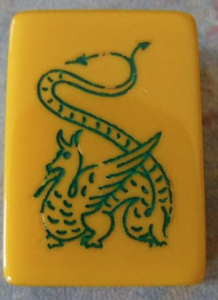Yesterday we touched upon reasons Mahjong sets become objects of desire. For many collectors, these dragons made by the Coronet Company, are the selling points. Who can resist these smoke blowing creatures?
These Dragons above, from an unknown manufacturer, have many of the features we have seen before, including horns and whiskers. Interestingly, the White Dragon is not a Dragon at all but a snake, one of the five poisonous creatures, often embroidered on children's clothing to ward off venomous dangers! The White Dragon appears a bit like some of the very elongated dragons we have seen before. The two Dragons have four toes, so these dragons were allowed to be used by low ranking officials. (Welch)
This Cardinal Company pair above has a red elongated Dragon as the Red, and the more squat Green one, very similar to that of the Royal Depth Control Dragon, seen below.
But look at these last two Green Dragons, they aren't like any dragons we have seen before! Why? We have yet to see a dragon with wings!! This must have been an attempt to appeal to the Western market, and was a real departure from Chinese dragons.
To refresh what Chinese dragons look like, we have a porcelain from the Lucas Collection ( as far as I can gather Lucas was the Director of the Asian Art Institute in Australia. ) Note the absence of wings on the dragon.
To end this post, look carefully at this screenshot of a photograph of a Dragon in China. More information and leads will be forthcoming, in a few days.
Mahjong tiles courtesy of Mahjongmahjong.












